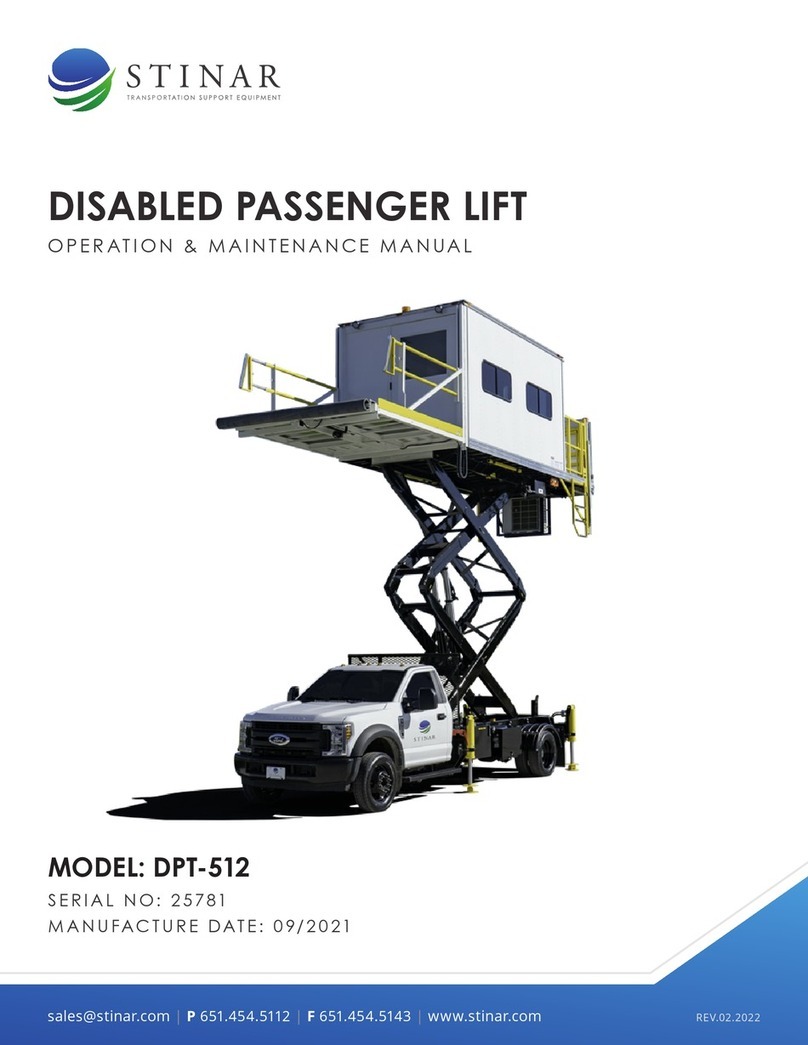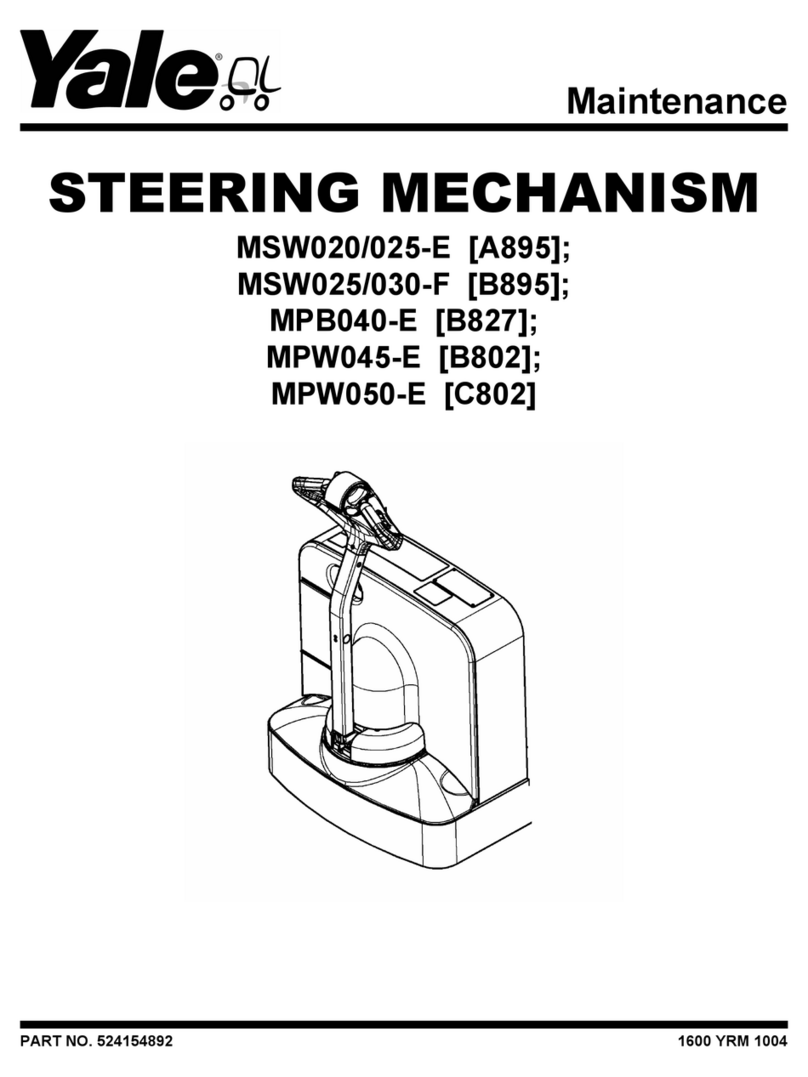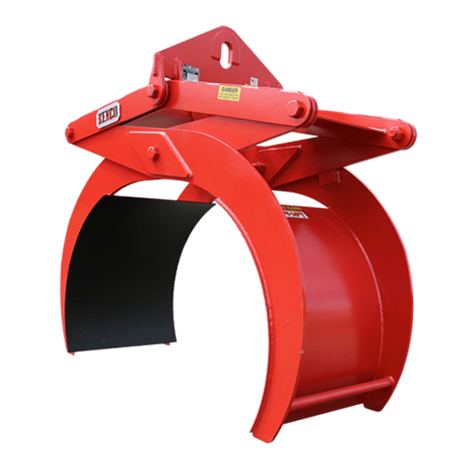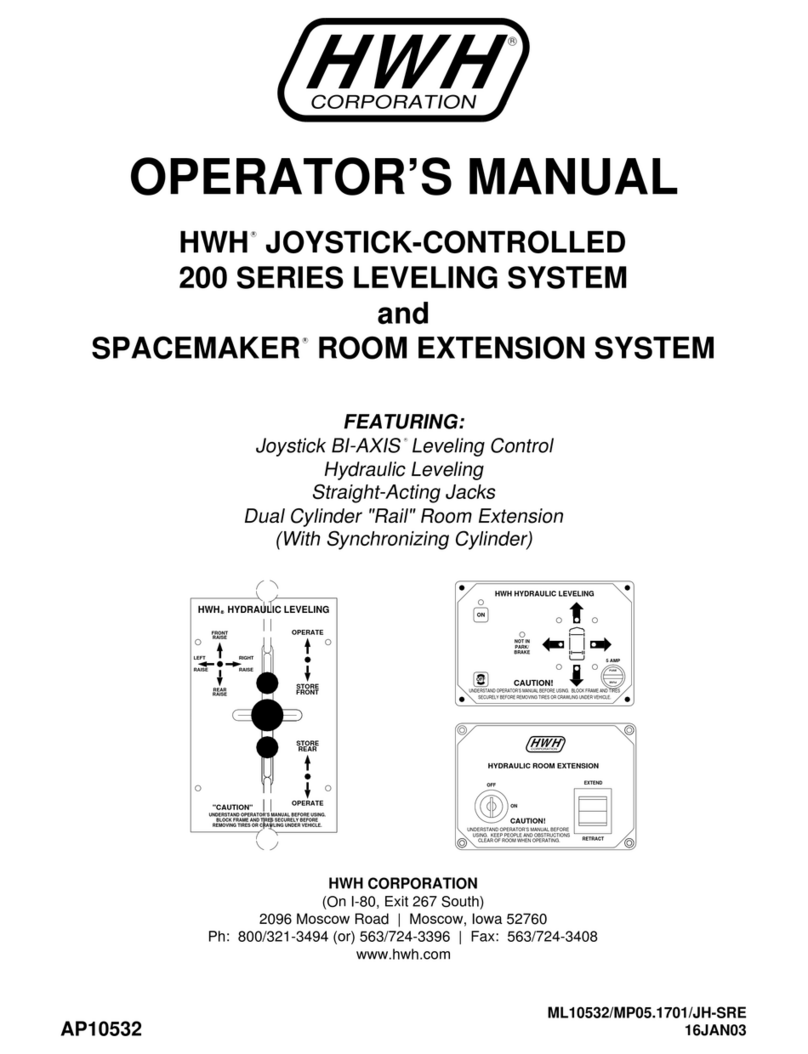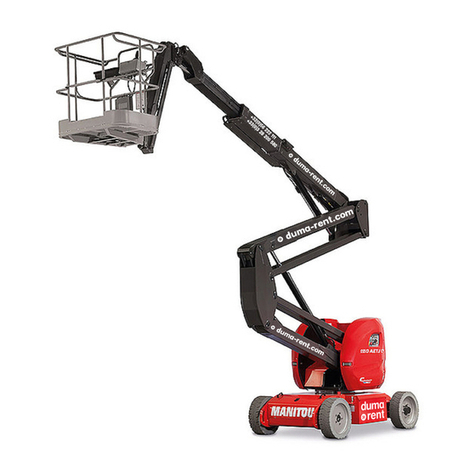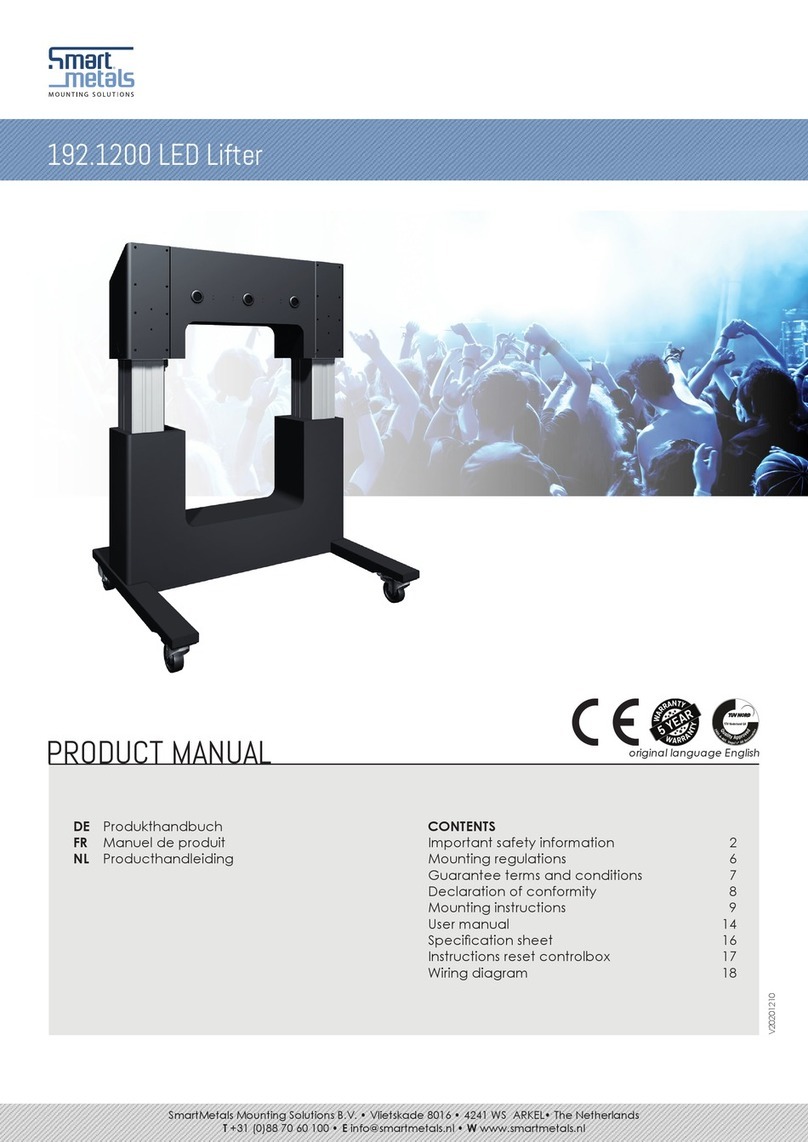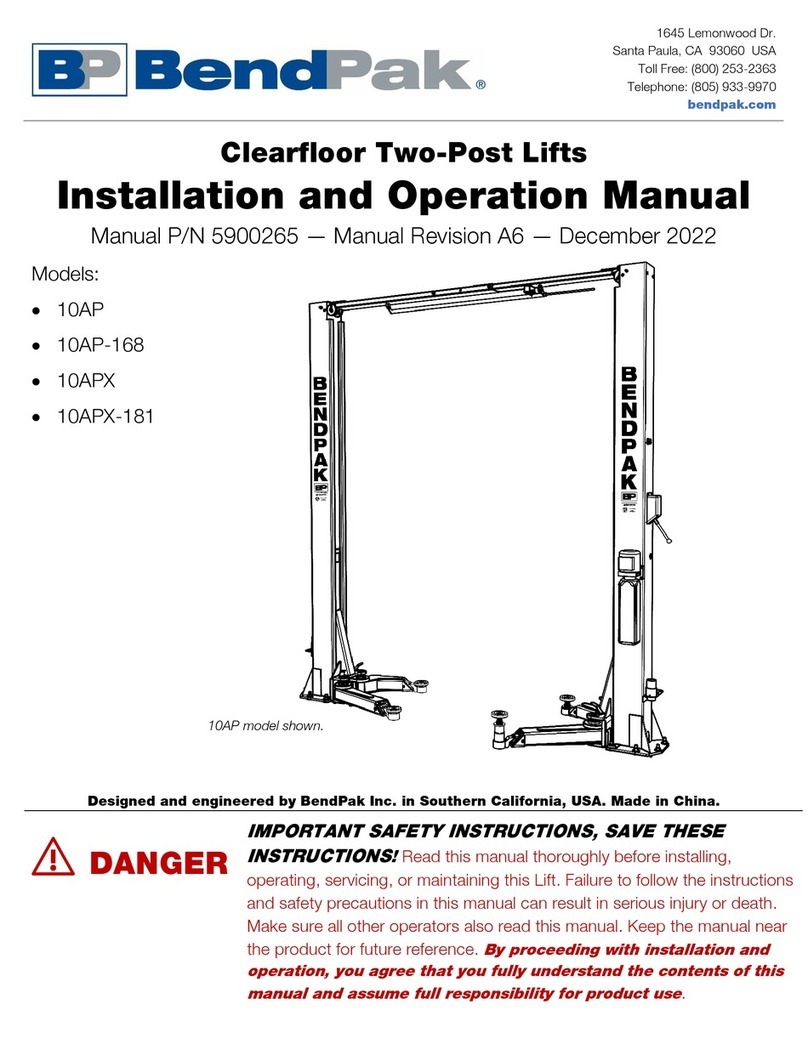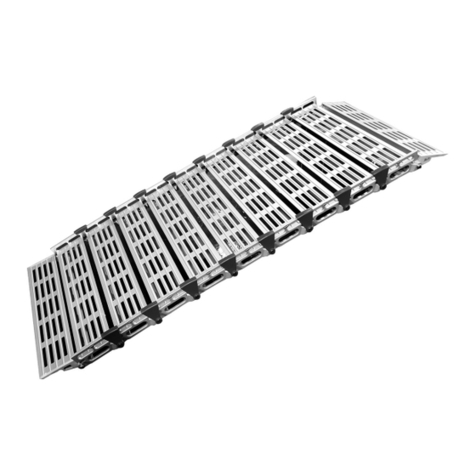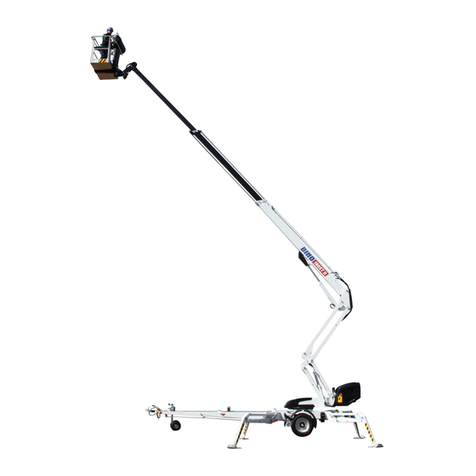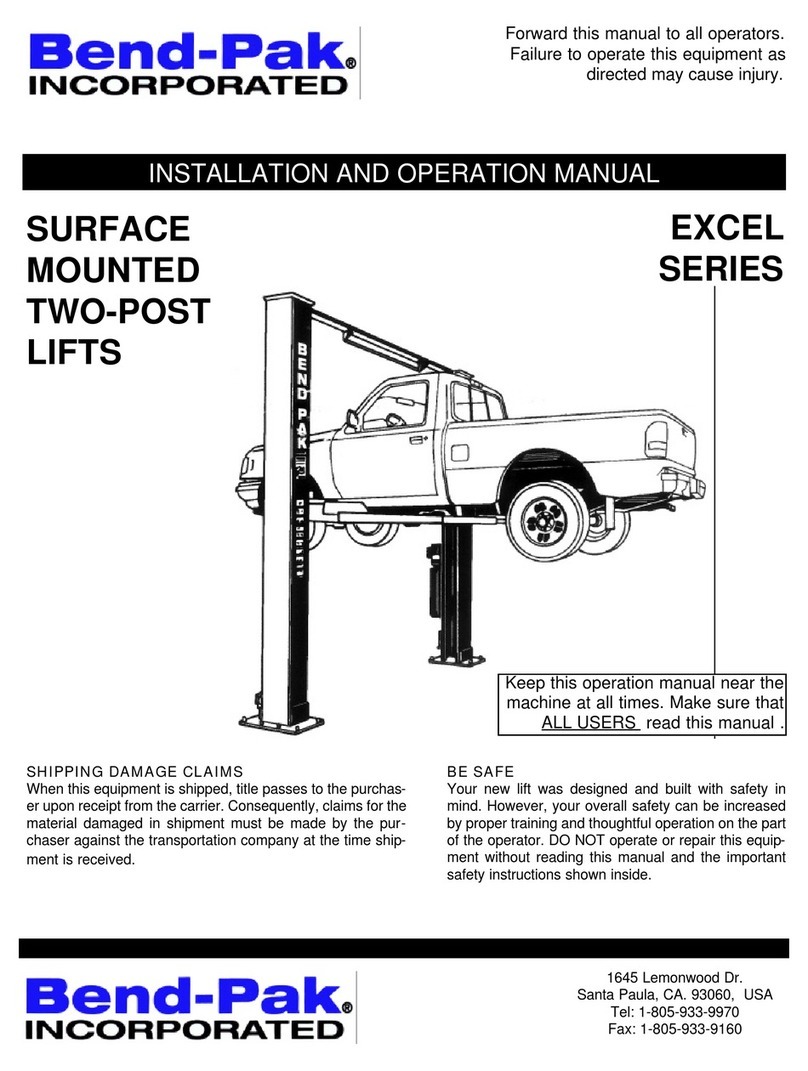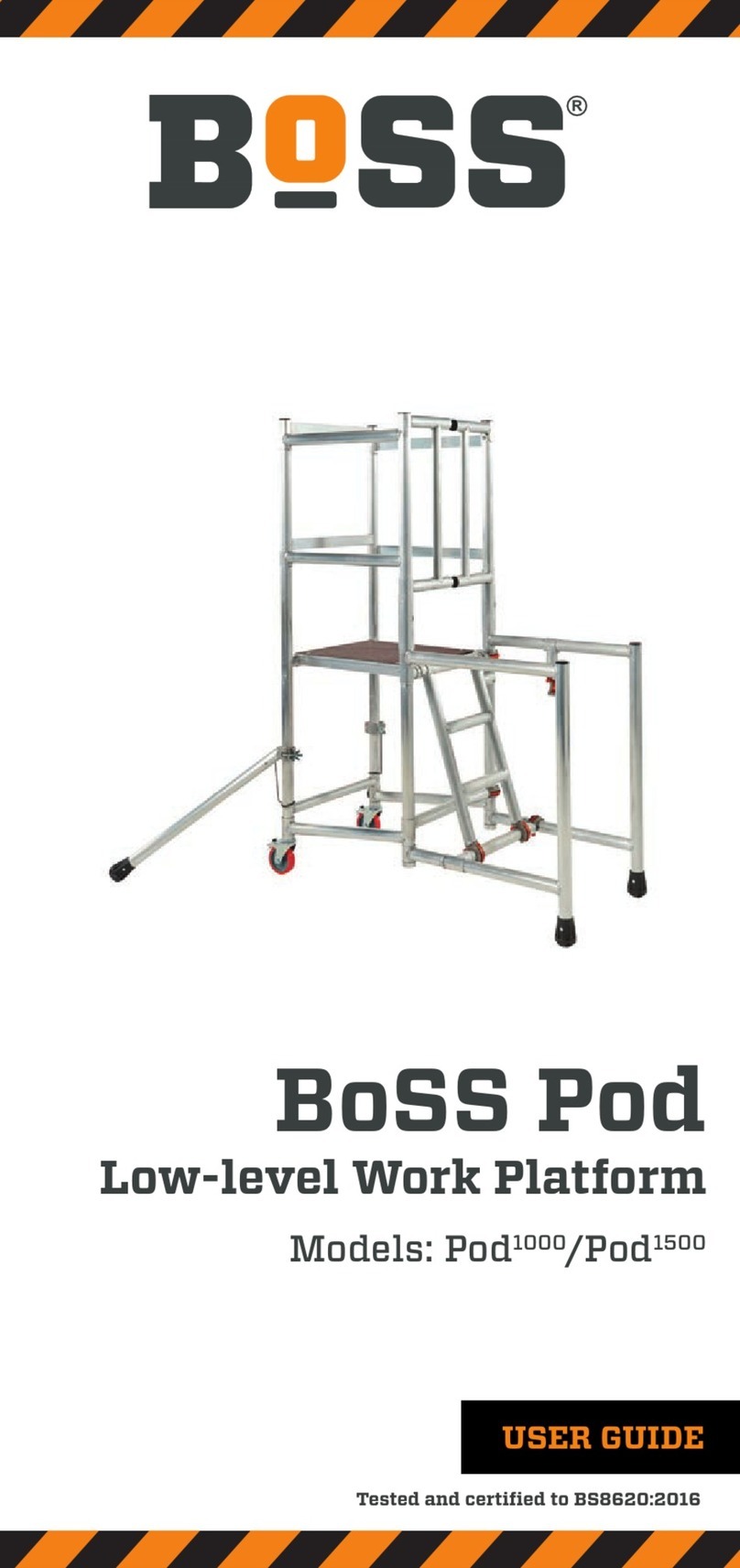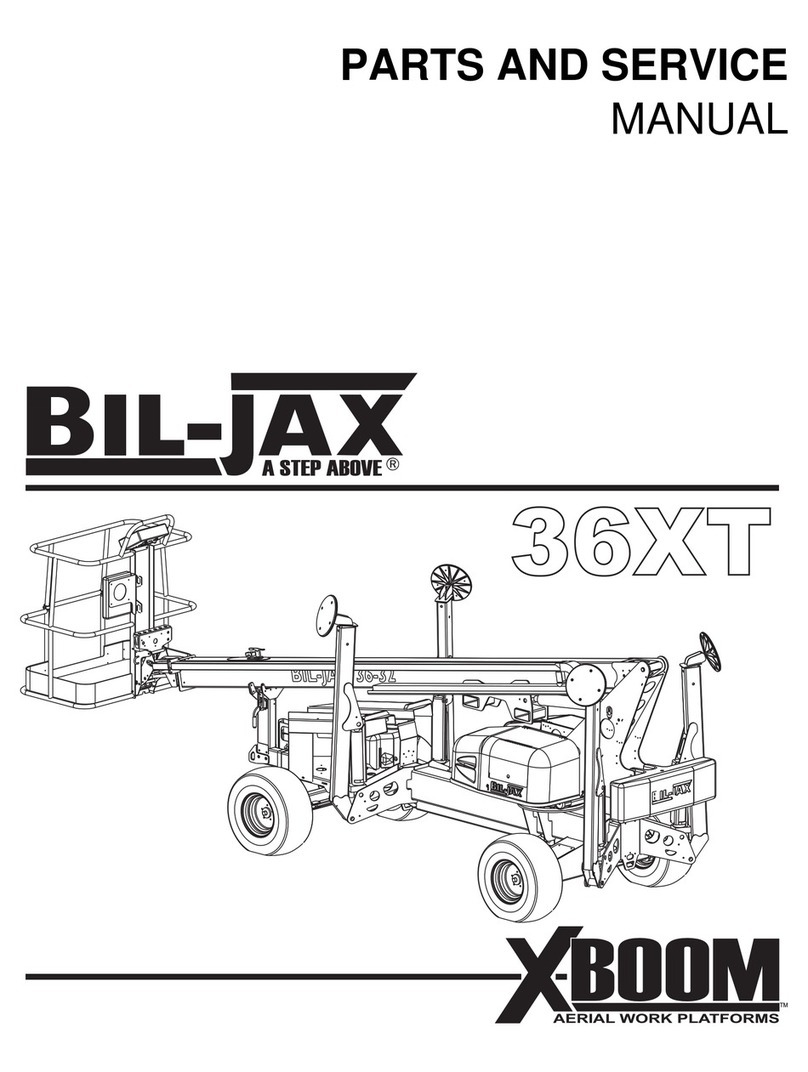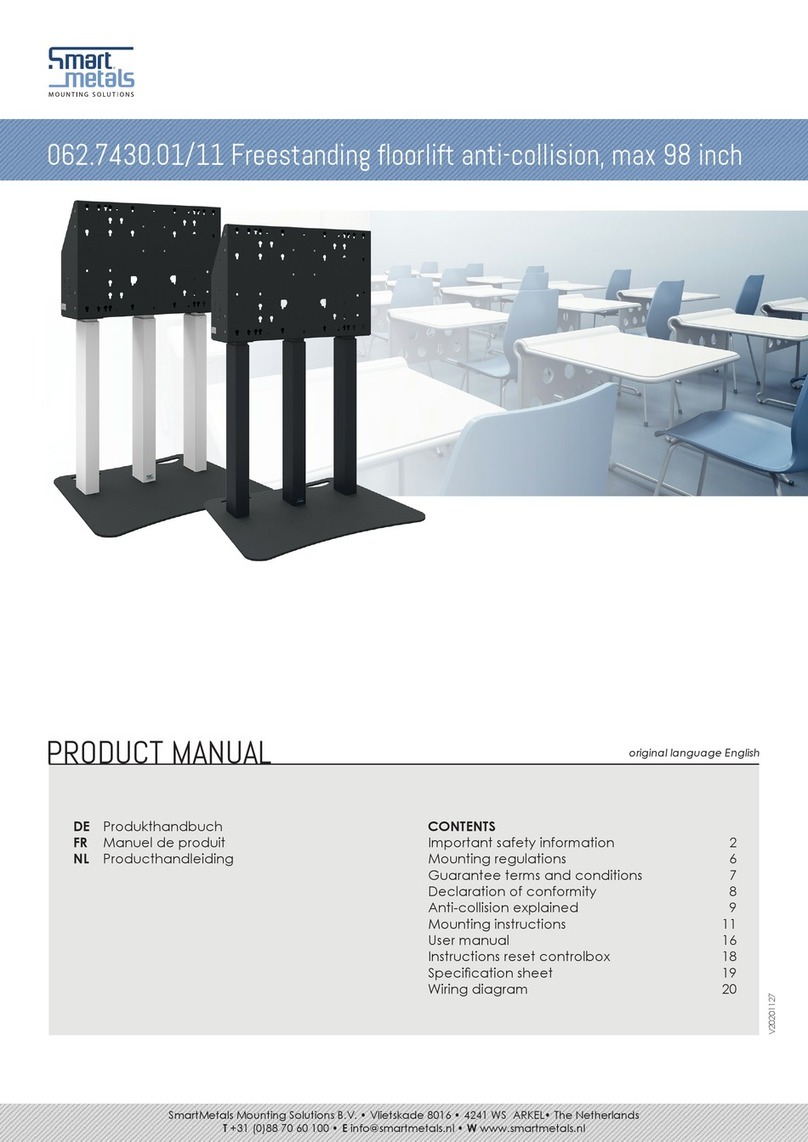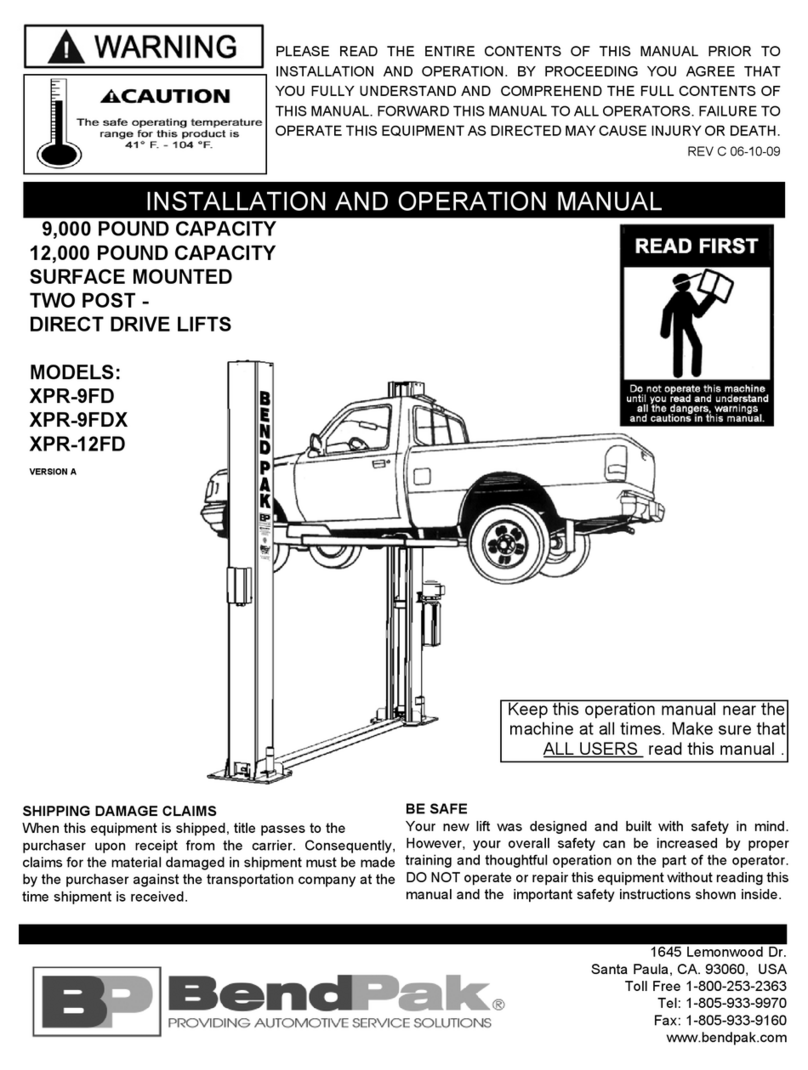STINAR PS-813B/E Manual

sales@stinar.com |P651.454.5112 |F651.454.5143 |www.stinar.com REV.10.2020
PASSENGER STAIRWAY
OPERATION & MAINTENANCE MANUAL
MODEL: PS-813B/E

Passenger Stairway PS-813B/E Boeing | 2
EFFECTIVE PAGES SECTION PAGE DATE
Title Page 1
List of Eective Pages 2
Contents 3
Introduction 7
SECTION 1
Section 1-1 8-13
Section 1-2 14-18
Section 1-3 19-20
SECTION 2
Introduction 23
Section 2-1 23-26
Section 2-2 27-29
Section 2-3 30
Section 2-4 31-32
SECTION 3
Section 3-1 33
SECTION 4
Intoduction 34
Section 4-1 35
Section 4-2 36

Passenger Stairway PS-813B/E Boeing | 3
TABLE OF CONTENTS GENERAL INFORMATION & OPERATING INSTRUCTIONS � � � � � 7
SECTION 1 - PROCEDURES, SPECS & CAPABILITIES � � � � � � � � � 8
1�1 Description � � � � � � � � � � � � � � � � � � � � � � � � � � � � 8
1.1.1 | Chassis . . . . . . . . . . . . . . . . . . . . . . . . . . . . . . . . . . . . . . . . . . . . . . . . 8
1.1.2 | Stairway, Platform and A-frame. . . . . . . . . . . . . . . . . . . . . . . . . . 8
1.1.2.1 | A-frame. . . . . . . . . . . . . . . . . . . . . . . . . . . . . . . . . . . . . . . . . . . . . . . . 8
1.1.2.2 | Lower Stairs Section . . . . . . . . . . . . . . . . . . . . . . . . . . . . . . . . . . . . . 9
1.1.2.3 | Upper Stairs Section . . . . . . . . . . . . . . . . . . . . . . . . . . . . . . . . . . . . . 9
1.1.2.4 | Platform . . . . . . . . . . . . . . . . . . . . . . . . . . . . . . . . . . . . . . . . . . . . . . 10
1.1.2.5 | Stabilizers . . . . . . . . . . . . . . . . . . . . . . . . . . . . . . . . . . . . . . . . . . . . . 10
1.1.2.6 | Gasoline Engine . . . . . . . . . . . . . . . . . . . . . . . . . . . . . . . . . . . . . . . 10
1.1.3 | Hydraulic System . . . . . . . . . . . . . . . . . . . . . . . . . . . . . . . . . . . . . 10
1.1.3.2 | Hydraulic Cylinders. . . . . . . . . . . . . . . . . . . . . . . . . . . . . . . . . . . . . 11
1.1.3.3 | Lock Valves . . . . . . . . . . . . . . . . . . . . . . . . . . . . . . . . . . . . . . . . . . . 11
1.1.3.4 | Flow Control Valves. . . . . . . . . . . . . . . . . . . . . . . . . . . . . . . . . . . . . 11
1.1.3.5 | Return Line Filter . . . . . . . . . . . . . . . . . . . . . . . . . . . . . . . . . . . . . . . 11
1.1.4 | Electrical System . . . . . . . . . . . . . . . . . . . . . . . . . . . . . . . . . . . . . . 12
1.1.4.1 | Lighting . . . . . . . . . . . . . . . . . . . . . . . . . . . . . . . . . . . . . . . . . . . . . . . 12
1.2.1 | Operating Controls and Indicators . . . . . . . . . . . . . . . . . . . . . . 13
1.2.1.1 | Engine Controls . . . . . . . . . . . . . . . . . . . . . . . . . . . . . . . . . . . . . . . . 13
1.2.1.2 | Primary Control Station (see Figure 1.2.1.2) . . . . . . . . . . . . . . . . . 13
1�2 Operation � � � � � � � � � � � � � � � � � � � � � � � � � � � � � 14
1.2.1.3 | Ratchet Release Handles . . . . . . . . . . . . . . . . . . . . . . . . . . . . . . . 14
1.2.1.4 | Auxiliary Hand Pump (see Figure 1.1.3) . . . . . . . . . . . . . . . . . . . . 14
1.2.1.5 | Battery Charger . . . . . . . . . . . . . . . . . . . . . . . . . . . . . . . . . . . . . . . 14
1.2.2 | Pre-Operation Checks . . . . . . . . . . . . . . . . . . . . . . . . . . . . . . . . . 14
1.2.3 | Operating Procedures . . . . . . . . . . . . . . . . . . . . . . . . . . . . . . . . . 14
1.2.3.3 | Towing and Positioning the Unit . . . . . . . . . . . . . . . . . . . . . . . . . . 15
1.2.3.4 | Raising the Stairway . . . . . . . . . . . . . . . . . . . . . . . . . . . . . . . . . . . . 16
1.2.3.5 | Lowering the Stairway . . . . . . . . . . . . . . . . . . . . . . . . . . . . . . . . . . 16
1.2.3.6 | Operating A-frame . . . . . . . . . . . . . . . . . . . . . . . . . . . . . . . . . . . . 16
1.2.3.7 | Boarding and Disembarking Passengers . . . . . . . . . . . . . . . . . . 16
1.2.3.8 | Removing the Stairway from Aircraft . . . . . . . . . . . . . . . . . . . . . 17
1.2.3.9 | Charging the Battery . . . . . . . . . . . . . . . . . . . . . . . . . . . . . . . . . . . 17
1.2.4 | Emergency Operating Procedures . . . . . . . . . . . . . . . . . . . . . . 17
1.2.4.1 | Operating Auxiliary Hand Pump . . . . . . . . . . . . . . . . . . . . . . . . . 17
1.2.4.2 | Raising Stairway or A-frame Using Hand Pump . . . . . . . . . . . . . 18
1.2.4.3 | Lowering Stairway or A-frame Using Hand Pump . . . . . . . . . . . 18
1.2.4.4 | Operating stabilizers Using Hand Pump . . . . . . . . . . . . . . . . . . . 18
1.3 Specications and Capabilities � � � � � � � � � � � � � � � � 19
1.3.1 | General Specications . . . . . . . . . . . . . . . . . . . . . . . . . . . . . . . . . 19
1.3.2 | Capacities. . . . . . . . . . . . . . . . . . . . . . . . . . . . . . . . . . . . . . . . . . . . 19
1.3.3 | Engine Specications . . . . . . . . . . . . . . . . . . . . . . . . . . . . . . . . . . 19
1.3.4 | Hydraulic System . . . . . . . . . . . . . . . . . . . . . . . . . . . . . . . . . . . . . 20

Passenger Stairway PS-813B/E Boeing | 4
1.3.5 | Electrical System. . . . . . . . . . . . . . . . . . . . . . . . . . . . . . . . . . . . . . 21
SECTION 2 - SERVICING PASSENGER STAIRWAY � � � � � � � � � � 23
2�1 Servicing � � � � � � � � � � � � � � � � � � � � � � � � � � � � � � 23
2.1.1 | Structural Components . . . . . . . . . . . . . . . . . . . . . . . . . . . . . . . . 23
2.1.1.1 | Sheet, Bar and Tubular Member (Non-Load Bearing). . . . . . . . 23
2.1.2 | Gasoline Engine. . . . . . . . . . . . . . . . . . . . . . . . . . . . . . . . . . . . . . . 23
2.1.2.1 | Servicing the Engine . . . . . . . . . . . . . . . . . . . . . . . . . . . . . . . . . . . 23
2.1.3 | Hydraulic System . . . . . . . . . . . . . . . . . . . . . . . . . . . . . . . . . . . . . 23
2.1.3.1 | Hydraulic Oil Tank . . . . . . . . . . . . . . . . . . . . . . . . . . . . . . . . . . . . . . 23
2.1.3.2 | Hydraulic Oil Filters . . . . . . . . . . . . . . . . . . . . . . . . . . . . . . . . . . . . . 23
2.1.3.3 | Pressure Relief Valve. . . . . . . . . . . . . . . . . . . . . . . . . . . . . . . . . . . . 24
2.1.3.4 | Flow Control Valves . . . . . . . . . . . . . . . . . . . . . . . . . . . . . . . . . . . . 24
2.1.4 | Electrical System (12 VDC) . . . . . . . . . . . . . . . . . . . . . . . . . . . . . . 24
2.1.4.1 | Electrical Cables, Wiring and Lights. . . . . . . . . . . . . . . . . . . . . . . 24
2.1.4.2 | Batteries and Charger . . . . . . . . . . . . . . . . . . . . . . . . . . . . . . . . . . 24
2.1.5 | Scheduled Servicing . . . . . . . . . . . . . . . . . . . . . . . . . . . . . . . . . . . 24
Table 2.1.5 | Scheduled Servicing. . . . . . . . . . . . . . . . . . . . . . . . . . . . . . 24
2.1.6 | Non-Scheduled Servicing . . . . . . . . . . . . . . . . . . . . . . . . . . . . . . 25
Table 2.1.6 | Non-Scheduled Servicing . . . . . . . . . . . . . . . . . . . . . . . . . 25
2.1.7 | Lubrication . . . . . . . . . . . . . . . . . . . . . . . . . . . . . . . . . . . . . . . . . . . 26
2.1.7.1 | Chassis, Stairway and A-frame . . . . . . . . . . . . . . . . . . . . . . . . . . . 26
Table 2.1.7.1 | Lubrication Points . . . . . . . . . . . . . . . . . . . . . . . . . . . . . . . . . 26
2.2 Troubleshooting � � � � � � � � � � � � � � � � � � � � � � � � � 27
Table 2.2.1 | Troubleshooting . . . . . . . . . . . . . . . . . . . . . . . . . . . . . . . . . 27
2.3 Adjustments � � � � � � � � � � � � � � � � � � � � � � � � � � � 30
2.3.1 | Hydraulic Pressure Relief Valve Adjustment . . . . . . . . . . . . . . 30
2.3.2 | Flow Control Valve Adjustment . . . . . . . . . . . . . . . . . . . . . . . . . 30
2.3.3 | Stairway Clearance Adjustment Bolts . . . . . . . . . . . . . . . . . . . 30
2.3.4 | Gasoline Engine Adjustment . . . . . . . . . . . . . . . . . . . . . . . . . . . 30
2.4 Removal and Installation � � � � � � � � � � � � � � � � � � � � 31
2.4.1 | Stair Assembly. . . . . . . . . . . . . . . . . . . . . . . . . . . . . . . . . . . . . . . . 31
2.4.1.1 | Removal . . . . . . . . . . . . . . . . . . . . . . . . . . . . . . . . . . . . . . . . . . . . . . 31
2.4.1.2 | Installation . . . . . . . . . . . . . . . . . . . . . . . . . . . . . . . . . . . . . . . . . . . . 31
SECTION 3 - OVERHAUL � � � � � � � � � � � � � � � � � � � � � � � � 33
SECTION 4 - PARTS � � � � � � � � � � � � � � � � � � � � � � � � � � � 34
4.1 Manufacturer Identication � � � � � � � � � � � � � � � � � � 35
4.2 Detailed Parts List � � � � � � � � � � � � � � � � � � � � � � � � 36
4.2.1 | Understanding the Columns . . . . . . . . . . . . . . . . . . . . . . . . . . . 36
4.2.1.1 | Figure/Item No. . . . . . . . . . . . . . . . . . . . . . . . . . . . . . . . . . . . . . . . . 36
4.2.1.2 | Manufacturer’s Part No. . . . . . . . . . . . . . . . . . . . . . . . . . . . . . . . . 36
4.2.1.3 | Description. . . . . . . . . . . . . . . . . . . . . . . . . . . . . . . . . . . . . . . . . . . . 36
4.2.1.4 | Vendor Code . . . . . . . . . . . . . . . . . . . . . . . . . . . . . . . . . . . . . . . . . 36
4.2.1.5 | Qty . . . . . . . . . . . . . . . . . . . . . . . . . . . . . . . . . . . . . . . . . . . . . . . . . . 36

Passenger Stairway PS-813B/E Boeing | 5
4.2.2 | How to Order Parts and Assemblies . . . . . . . . . . . . . . . . . . . . 36
PARTS ORDER FORM � � � � � � � � � � � � � � � � � � � � � � � � � � 37
Fig 1.1 | Passenger Stairway, Model PS-813B/E 38
Fig 1.1.2.1 | A-frame 39
Fig 1.1.3 | Hydraulic Schematic 40
Fig 1.1.3.1 | Primary Control Station 41
Fig 1.1.4 | Electrical Schematic 42
Figure 1.2.1.2 | Primary Control Station 43
Figure 2.1.7.1 | Lubrication Points 44
Figure 2.1.7.2 | Lubrication Points 45
Figure 2.1.7.3 | Lubrication Points 46
Figure 2.2.1.1 | Hydraulic Schematic 47
Figure 2.2.1.2 | Electrical Schematic 48
Figure 2.3.1 | Primary Control Valve 49
Figure 2.3.3 | Adjustment Bolts 50
Figure 4.3.1 | Passenger Stairway, Model PS-813B/E 51
Figure 4.3.1 | Passenger Stairway, Model PS-813B/E - Table 52
Figure 4.3.1 | Passenger Stairway, Model PS-813B/E - Table Pt.2 53
Figure 4.3.2 | Stairway Chassis Assembly 54
Figure 4.3.2 | Stairway Chassis Assembly - Table 55
Figure 4.3.3 | Upper Stairs and Platform 56
Figure 4.3.3 | Upper Stairs and Platform - Table 57
Figure 4.3.4 | Lower Stairs Assembly 58
Figure 4.3.4 | Lower Stairs Assembly - Table 59
Figure 4.3.5 | Stairway Ratchet Assembly 60
Figure 4.3.5 | Stairway Ratchet Assembly - Table 61
Figure 4.3.6 | A-frame Assembly 62
Figure 4.3.6 | A-frame Assembly - Table 63
Figure 4.3.7 | Hydraulic System 64
Figure 4.3.7 | Hydraulic System - Table 65
Figure 4.3.8 | Stairway Extend Cylinder 66
Figure 4.3.9 | Electrical Schematic 67
Figure 4.3.9 | Electrical Schematic - Table 68
Figure 4.3.10 | Control Station 69
Figure 4.3.10 | Control Station - Table 70

Passenger Stairway PS-813B/E Boeing | 6
SECTION / SECTION PAGE DATE
REVISIONS PAGE

Passenger Stairway PS-813B/E Boeing | 7
This publication provides operating and maintenance instructions,
including detailed part lists for the Passenger Stairway, Model PS-813B/E.
This unit was manufactured by:
Stinar, LLC
10061 State Hwy. 30
Blooming Prairie, MN 55917
Section 1
Includes a unit description, recommended procedures for operation, plus
specications and capabilities.
Section 2
Provides unit maintenance information, service and lubrication data, a
troubleshooting guide and adjustment information.
Section 3
Presents instructions for component overhaul and repair.
Section 4
Contains a manufacturers’ list and illustrated parts lists for the
assemblies, sub-assemblies and systems within the unit.
GENERAL INFORMATION & OPERATING INSTRUCTIONS

Passenger Stairway PS-813B/E Boeing | 8
SECTION 1 - PROCEDURES, SPECS & CAPABILITIES
The Stinar Model PS-813B/E Passenger Stairway (see Figure 1.1) is a towable
passenger boarding stairway. Height adjustment is made by means of a
telescoping A-frame mechanism and the upper stairs telescoping into the
lower stairs. The stairway incorporates an aircraft boarding platform at
the top of the stairs. The platform provides access to aircraft cabins with
doorsill heights ranging from 96 in. (2440 mm) to 228 in. (5790 mm) above
ground level. Four hydraulically-operated stabilizers provide stability when
the stairway is raised.
A gasoline engine on the chassis is coupled to a hydraulic pump that
operates whenever the engine is running. The pump provides hydraulic
power to raise and lower the stairway, A-frame and stabilizers. A
hand pump provides emergency power in case of main power failure.
Mechanical ratchets lock the stairway and A-frame in position. A 12 VDC
electrical system provides power for illuminating the stairs and for the
engine electric starter.
1.1.1 | Chassis
The stairway chassis is a steel channel frame to which the stairway sub-
assemblies are attached. The chassis is tted with spring-loaded dual-
wheel casters at the stairs end and with a rigid axle beneath the A-frame.
The axle is tted with hubs having automotive-type bearings. The wheels
have ve bolts and 8 in. rims and are tted with 4:00 x 8 solid tires.
Mounting brackets for the stairway and A-frame are provided at opposite
ends of the chassis. A stabilizer is attached to each corner of the frame.
The frame provides mounting brackets for the electrical system and the
hydraulic system and for the engine.
A tow bar is attached to the stairway/chassis for towing purposes. When
not in use, the tow bar should be lifted and latched to the chassis.
1.1.2 | Stairway, Platform and A-frame
The elevating stairway consists of two stair sections supported by a
telescoping A-frame. The lower stairs assembly is attached to the chassis
by a shaft, which enables the stairs to pivot. The top of the lower stairway
is connected to the chassis by the A-frame assembly. The A-frame
permits the angle of inclination (and thus the platform height) of the
stairway to be adjusted. The upper stairs section, which includes the
platform, can be extended and retracted.
1.1.2.1 | A-frame
The A-frame assembly (see Figure 1.1.2.1) supports the stairs sections and
can be raised or lowered to adjust the angle of the stairway and platform.
The A-frame consists of two sections.
1. The inner A-frame is the lower of the two sections. The base of the
inner A-frame is secured by pivot pins to a support bracket welded
to the chassis.
1.1 DESCRIPTION
SECTION 1 - PROCEDURES, SPECS & CAPABILITIES

Passenger Stairway PS-813B/E Boeing | 9
SECTION 1 - PROCEDURES, SPECS & CAPABILITIES
2. The outer A-frame is the upper A-frame section. This section slides
up and down over the inner section. Two hydraulic cylinders raise or
lower the outer A-frame. The top of the outer A-frame is attached to
the lower stairs section.
3. NOTE: The A-Frame ratchet does not have to be locked in ratchet
stop for normal operation. It is intended as a safety device in the
event of cylinder failure. The ratchet assembly (dogs) must operate
freely into any position on the ratchet stops on the A-Frame.
The A-frame ratchet assembly mechanically locks the A-frame at
various positions. The ratchet assembly consists of a ratchet shaft
equipped with ratchet dogs and a hand lever for engaging the ratchet
dogs to ratchet stops on the A-frame. The ratchet is secured in the
engaged position by the o-center weight of the handle.
1�1�2�2 | Lower Stairs Section
The lower stairs section consists of fteen aluminum steps with tread
surfaces and two side panels, which incorporate handrails. The stairs may
be illuminated by lights installed in the side panels.
The base of the lower stairs section is mounted to the stairway chassis
by means of a shaft, which enables the lower section to pivot when the
A-frame is extended.
The upper portion of the lower stairs section is supported by the
A-frame. Rollers at the upper end support the upper stairs and permit it
to slide freely.
A stair ratchet assembly is attached to the underside of the lower stairs
section. This assembly consists of a ratchet shaft, ratchet dogs and a
manually-operated lever. The ratchet dogs lock the upper stairs section
in position by engaging stops welded to the bottom of the upper stairs
section. The stairs ratchet is released manually by operating the hand
lever.
1�1�2�3 | Upper Stairs Section
The upper stairs section consists of fourteen aluminum steps with tread
surfaces, two side panels with handrail and the service platform. The
upper section is attached to the lower section through a channel on each
side of the lower stairs section. Two rollers are installed on each side at
the lower end of the upper section, enabling the upper section to move
up and down smoothly.
The upper section is raised and lowered by the stairway hydraulic cylinder.
The upper end of this long, slender cylinder is attached to the platform. The
lower end of the cylinder is secured at the base of the lower stair section.
NOTE:
The A-Frame ratchet does not
have to be locked in ratchet
stop for normal operation. It
is intended as a safety device
in the event of cylinder failure.
The ratchet assembly (dogs)
must operate freely into any
position on the ratchet stops
on the A-Frame.

Passenger Stairway PS-813B/E Boeing | 10
SECTION 1 - PROCEDURES, SPECS & CAPABILITIES
1.1.2.4 | Platform
The platform is part of the upper stairway and is welded to the upper
stairway side channels. The platform oor is fabricated from diamond
tread plate. Side panels on the platform slide back and forth on rollers
and can be latched in place by means of foot latches. Two platform
lights illuminate the platform during night operations. The front of the
platform has a rubber bumper to protect the aircraft. A 12” extension
and swivel assembly are to help nal positioning and alignment of the
platform to the aircraft.
1.1.2.5 | Stabilizers
This unit is equipped with four stabilizer assemblies at the corners to
stabilize the stairway and to keep it locked in place. The stabilizers are
hydraulic cylinders with stabilizer pads at the bottom that are raised and
lowered hydraulically.
1.1.2.6 | Gasoline Engine
The engine which drives the hydraulic pump is a gasoline engine with an
electric starter. It receives fuel from an integral fuel tank located above
the engine. Engine controls are located on the engine.
1.1.3 | Hydraulic System
The hydraulic system (see Figure 1.1.3) provides hydraulic power to raise
and lower the upper stairway, A-frames and stabilizers. It consists of the
following components:
COMPONENT DESCRIPTION
Hydraulic Tank
The hydraulic uid tank is located on the side of the
chassis. The tank is provided with an in-tank uid
strainer. A dipstick is incorporated into the tank ll
cap. A clean-out port is located on top of the tank. A
drain plug is located at the bottom of the tank.
Hydraulic Pump
The hydraulic pump provides hydraulic power to
operate the stairway, A-frame and stabilizer cylinders.
The hydraulic pump is an internal gear (rotor) pump
coupled to the gasoline engine output shaft. It
operates whenever the engine is running. The pump
draws hydraulic oil from the hydraulic tank.
Auxiliary Hand Pump
The hand pump is located adjacent to the hydraulic
control valve and is equipped with an extension
handle. The hand pump provides emergency hydraulic
power for operating the stairs, A-frames and stabilizer
cylinders if the engine-driven pump is disabled.

Passenger Stairway PS-813B/E Boeing | 11
SECTION 1 - PROCEDURES, SPECS & CAPABILITIES
COMPONENT DESCRIPTION
Check Valve
The check valve is included in the hydraulic pump
line to prevent hydraulic pressure from backing up
against the main pump when the hand pump is used.
Directional Control
Valve (see Figure
1.1.3.1)
The directional control valve is a three-spool valve
incorporating an adjustable pressure relief valve.
One valve spool directs oil to and from the A-frame
cylinders. Another controls the stairway cylinder. The
third spool controls the four stabilizer cylinders. Each
spool is manually-operated by a control handle.
The control valve is considered “power beyond”. If
equipped, excess oil from the control valve ows to
the control valve which controls the ow of hydraulic
oil of the hydraulic motor powering the drive wheel.
Pressure Relief Valve
The system relief valve is part of the directional
valve. It can be adjusted manually by turning an
adjustment screw.
1.1.3.2 | Hydraulic Cylinders
This unit has seven hydraulic cylinders for raising and lowering the
stairway, A-frame and stabilizers.
COMPONENT DESCRIPTION
Stairway Cylinder
The stairway cylinder is located beneath the
stairway. A lock valve and a ow control valve are
located near the inlet/outlet port of this cylinder.
A-frame Cylinders The A-frame contains two cylinders. A lock valve and
a ow control are provided for these two cylinders.
Stabilizer Cylinders
Four stabilizer cylinders are located near the corners
of the stairway chassis. There is one lock valve on
each cylinder.
1.1.3.3 | Lock Valves
There are six lock valves in the system (see Hydraulic Cylinders above).
The lock valves trap uid under pressure when the pump is shut o,
locking the cylinders in position.
1.1.3.4 | Flow Control Valves
Flow control valves on the A-frame and stairway cylinders regulate the
lowering speed of the A-frame and stairway.
1.1.3.5 | Return Line Filter
The return line lter puries hydraulic oil returning to the tank. This lter

Passenger Stairway PS-813B/E Boeing | 12
SECTION 1 - PROCEDURES, SPECS & CAPABILITIES
has a 10–micron replaceable canister. It is located at the front of the
hydraulic tank.
1.1.4 | Electrical System
The electrical system is a 12 VDC system used for illuminating the stairway
and powering the stairway engine electrical starter. Major electrical
components are described below. See Figure 1.1.4 for electrical schematic.
COMPONENT DESCRIPTION
Battery Charger
The battery charger is provided for maintaining the
batteries at peak levels. The battery charger has a 15
amp. maximum output and an automatic charging
rate. The charger receives 120 VAC current through a
power cord on the charger.
Batteries
The two 6V marine deep cycle batteries provide
power for the electrical lighting and the engine
electric starter. The batteries are located in plastic
battery boxes. They are kept charged by a battery
charger (located in an adjacent battery box) that has
a rated capacity of 220 amp./hr. at 32˚F.
Fuse
The 30 amp. mini fuse protects the lights circuit from
overloads. The fuse is located inside a plastic fuse
holder near the hydraulic motor.
Circuit Breaker
A 80 amp. re-settable circuit breaker protects
the engine start circuit from overloads. It is
located on the chassis frame near the batteries.
Lighting Control
Switch
The LIGHT ON/OFF control switch (toggle) for
the stairway, platform and A-frame lights is
mounted on the primary control station.
Alternator
The engine alternator provides current to the
batteries which keep them from being depleted
during stairway operations. The engine on this
unit is equipped with a heavy duty 18 amp.
alternator and rectier.
1.1.4.1 | Lighting
COMPONENT DESCRIPTION
Stairway Lights
The stairway lights mounted in the upper and lower
stairs side panels illuminate the stairway during
night operations.
Platform Lights
The two platform lights faired into the front of the
platform illuminate the platform during nighttime
operations.
NOTE:
Electrical power for the stair-
way is provided by two 6 V
deep cycle batteries, which are
kept charged by a battery char-
ger. The charger operates when
plugged into an external 120
VAC power source. When the
engine is running, the engine
alternator helps keep the bat-
teries from becoming depleted.

Passenger Stairway PS-813B/E Boeing | 13
SECTION 1 - PROCEDURES, SPECS & CAPABILITIES
Floodlight The oodlight located on the A-frame illuminates the
aircraft as it is being approached by the stairway unit.
This section of the manual provides information on the operating
controls and indicators and provides operating procedures for the
Passenger Stairway. Prior to operating the passenger stairway, all
operators and maintenance personnel should become thoroughly
familiar with the instructions given in this manual. They should then be
checked out by a qualied instructor before operating the unit.
1.2.1 | Operating Controls and Indicators
1.2.1.1 | Engine Controls
The hydraulic pump on this unit is powered by the gasoline engine. The
engine controls are located on the engine. See the engine manual in
Appendix A for illustrations and information.
1.2.1.2 | Primary Control Station (see Figure 1.2.1.2)
COMPONENT DESCRIPTION
Lighting Control
Switch
The ON/OFF switch controls the stairway
courtesy lights and the A-frame oodlight.
Stairway Control
Handle
The handle controls the cylinder that raises the
upper stairs/platform. Placing the handle in
the UP position raises the stairway. Placing the
handle in the DOWN position releases the stairs
cylinder lock valve and retracts the cylinder.
This handle is used along with the stair ratchet
release handle to lower the stairway. The
stairway cylinder cannot retract unless the
ratchet is rst released manually.
A-frame Control
Handle
The handle controls the cylinder that raises the
A-frame. Placing the handle in the UP position
raises the A-frame. Placing the handle in the
DOWN position releases the A-frame lock valve
and retracts the cylinder.
This handle is used along with the A-frame
ratchet release handle to lower the A-frame. The
A-frame cannot retract unless the ratchet is rst
released manually.
Stabilizer Control
Handle
The handle controls the four stabilizer cylinders.
Placing the handle in the DOWN position extends
(lowers) the stabilizers. Placing the handle in the
UP position retracts (raises) the stabilizers.
NOTE:
A cord reel near the base of
the stairway enables the wiring
cord for the upper stairs and
platform lights to extend and
retract as the stairway is raised
and lowered.

Passenger Stairway PS-813B/E Boeing | 14
SECTION 1 - PROCEDURES, SPECS & CAPABILITIES
1.2.1.3 | Ratchet Release Handles
COMPONENT DESCRIPTION
A-frame Ratchet
Release Handle
The handle on the side of the A-frame manually
unlocks the A-frame ratchet to permit lowering
the A-frame.
Stairway Ratchet
Release Handle
The handle on the side of the stairway manually
unlocks the stairway ratchet to permit retracting
the upper stairs and platform.
1.2.1.4 | Auxiliary Hand Pump (see Figure 1.1.3)
The hand pump is located adjacent to the hydraulic control valve and
is equipped with an extension handle. The hand pump is intended for
Emergency Operation Only in the event the primary power system
cannot be used.
1.2.1.5 | Battery Charger
The battery charger charges the batteries that power the engine starter
and the stairway and A-frame lights.
1.2.2 | Pre-Operation Checks
Carefully check the following before putting the unit in service.
1. Check to see that all nuts, bolts and other fasteners are tight.
2. Check wheels and casters for proper operation.
3. Check the level of the hydraulic uid in the hydraulic oil tank. Add
hydraulic oil if level is low.
4. Check engine oil level.
5. Check battery terminals for corrosion and tightness.
6. Fill engine gasoline tank.
7. Check electrical system for proper operation.
8. Check stairway and platform lights for damage and proper operation.
9. Make sure that the stairs are free from any objects that could cause
a passenger to slip or fall.
10. Check platform modesty panels for free movement and proper latching.
1.2.3 | Operating Procedures
11. Start engine in accordance with procedures below. Read engine
manual in Appendix A before starting engine.
1.2 OPERATION

Passenger Stairway PS-813B/E Boeing | 15
SECTION 1 - PROCEDURES, SPECS & CAPABILITIES
• Move the fuel valve lever to the ON position.
• Move choke lever to CLOSED position if engine is cold. To restart
a warm engine, leave the choke lever in the OPEN position.
• Move engine throttle about 1/3 of the way to the FAST position.
• Operate the starter by moving the engine switch to the START
position.
• If engine cranks but will not re, it may be necessary to adjust
the choke. See Appendix A for illustrations and procedure. If
engine cannot be started using electric starter, it may be started
manually by means of pull starter.
12. After engine starts, move choke to OPEN position as the engine
warms up. Operate engine with choke in OPEN position and throttle
in FAST position.
13. When engine is running smoothly, stairway operations may begin.
14. Shut o engine by moving throttle lever to the SLOW position and
moving engine switch to the OFF position.
15. Turn the fuel valve lever to the OFF position.
1.2.3.3 | Towing and Positioning the Unit
1. Connect tow bar to tow vehicle.
2. Ensure that the stairway is disconnected from 120 VAC electrical power.
3. Ensure that stabilizers are raised.
4. Tow stairway to vicinity of aircraft. Do not tow at speeds over 15 mph.
5. Position unit in line with the aircraft doorway, 20 to 30 ft. from the
aircraft.
6. Start engine following procedures above. Engine powers hydraulic
pump.
7. Raise stairs to proper aircraft service height following procedures
below.
8. Raise A-frame to aircraft door sill height.
9. Push unit forward until rubber bumper makes slight contact with
aircraft.
10. Lower stabilizers as follows:
• Move STABILIZER control valve handle to DOWN position (with
engine running).
• Hold control valve handle in DOWN position until all stabilizers
are fully lowered.
WARNING!
Do not allow any part of the
unit to come into contact with
electrically charged wires. STAY
OFF THE STAIRS AND PLAT-
FORM while towing or operat-
ing the stairway.
CAUTION!
Make sure there is hydraulic oil
in the hydraulic oil reservoir be-
fore starting the engine. This is
necessary because the hydrau-
lic pump operates whenever the
engine is running.

Passenger Stairway PS-813B/E Boeing | 16
SECTION 1 - PROCEDURES, SPECS & CAPABILITIES
11. Adjust A-frame height until platform is level with door sill and
platform bumper makes slight contact with aircraft.
1.2.3.4 | Raising the Stairway
1. Ensure that the stairway engine is running.
2. Raise stairway by holding STAIRWAY control valve handle (Figure
1.1.3.1) in UP position. Continue to raise stairway until upper stairs
steps are about 1 inch above lower stairs steps.
3. Lower stairs until the mechanical lock on the stairs ratchet engages.
See procedures below.
1.2.3.5 | Lowering the Stairway
1. Raise stairway approximately 1 inch to clear ratchet.
2. Raise stairway ratchet release handle.
3. Move STAIRWAY control valve handle to DOWN position. Hold until
stairway is at desired height. Stairs may be stopped at any ratchet
position by releasing the ratchet handle.
1.2.3.6 | Operating A-frame
1. Push unit forward until platform bumper makes slight contact
with aircraft.
2. Ensure that engine is running.
3. Lower the stabilizers, as this will cause the platform to raise slightly.
4. Adjust A-frame height so that platform is level with door sill and
platform bumper makes slight contact with aircraft.
5. To raise A-frame, proceed as follows:
• Move A-FRAME control valve handle to UP position and hold
until A-frame is at desired height.
6. To lower the A-frame, proceed as follows:
• Move A-FRAME control valve handle to UP position. Raise
A-frame approximately 1 in. to clear ratchet.
• Raise A-frame ratchet release handle.
• Move A-FRAME control valve handle to DOWN position. Hold
until platform is at desired height.
1.2.3.7 | Boarding and Disembarking Passengers
1. Push stairway into position using procedures above. With engine
running, adjust platform height and position stairway so that
platform bumper is in contact with aircraft.
2. Lower stabilizers by holding the stabilizer down lever until all
stabilizers are fully down.
WARNING!
Do not start or run engine in
a closed or poorly ventilated
building where exhaust gases
can accumulate. Avoid breath-
ing these gases as they contain
poisonous carbon monoxide,
which can endanger your
health or life.
CAUTION!
Using the electric starter for
more than ve seconds at a
time will overheat the starter
motor and can damage it.
CAUTION!
DO NOT MOVE CHOKE CON-
TROL TO CLOSED POSITION TO
STOP ENGINE. Backre or en-
gine damage may occur. Move
throttle control to SLOW posi-
tion, then switch engine OFF.

Passenger Stairway PS-813B/E Boeing | 17
SECTION 1 - PROCEDURES, SPECS & CAPABILITIES
3. For night operations, turn on stairway, platform and A-frame lights
by engaging LIGHTS switch (Figure 1.1.3.1).
4. Proceed to top of stairs and slide platform side panels rearward.
5. Open aircraft door as prescribed in the airline manual.
6. Slide side panels forward until they latch.
1.2.3.8 | Removing the Stairway from Aircraft
1. Slide platform side panel away from door.
2. Close the aircraft door as prescribed by the aircraft manual.
3. Secure platform side panels by latching with foot latch in one of
the stops.
4. Raise stabilizers as follows:
• Ensure that the engine is running.
• Place and hold STABILIZER control valve handle in UP position
until stabilizers are fully raised.
5. Pull stairway a short distance away from aircraft. Stairway can now
be lowered.
6. Tow stairway away from vicinity of aircraft.
1.2.3.9 | Charging the Battery
Two 6 V batteries provide electrical power for the engine electric starter
and the stairway and A-frame lights. These batteries are charged by
means of a battery charger which requires external 120 VAC power
supplied through a power cord on the charger.
1. To charge the batteries, connect facility 120 V, 60 Hz power to
stairway battery charger cord. Charger functions whenever the unit
is plugged in.
2. Always disconnect external power cord before towing stairway.
1.2.4 | Emergency Operating Procedures
In case the engine, hydraulic system or electrical system is disabled, the
stairway unit should be towed away from the aircraft and repaired. If
the stabilizers are down, raise the stabilizers (using auxiliary hand pump)
before towing the stairway unit.
1.2.4.1 | Operating Auxiliary Hand Pump
The auxiliary hand pump provides emergency hydraulic power for
operating the stairway, A-frame and stabilizers in case the engine-
NOTE:
Stairway should be raised to
service height before adjusting
A-frame height.
NOTE:
The A-Frame ratchet does not
have to be locked in ratchet
stop for normal operation. It
is intended as a safety device
in the event of cylinder failure.
The ratchet assembly (dogs)
must operate freely and be
in with the ratchet bars on
the A-Frame for normal safe
operation.
NOTE:
The side panel locks are on
the platform oor and can be
released by foot.

Passenger Stairway PS-813B/E Boeing | 18
SECTION 1 - PROCEDURES, SPECS & CAPABILITIES
powered hydraulic pump is disabled. The hand pump is located near the
hydraulic control valve and is equipped with an extension handle. It is
operated by moving the handle back and forth repeatedly.
1.2.4.2 | Raising Stairway or A-frame Using Hand Pump
1. Hold STAIRWAY or A-FRAME control valve handle in UP position.
Pump hand pump until stairway or A-frame is at desired height.
2. Move control handle to DOWN position. Pump hand pump until
mechanical ratchet lock engages.
1.2.4.3 | Lowering Stairway or A-frame Using Hand Pump
1. Raise stairway or A-frame approximately 1 in. to clear ratchet.
2. Raise ratchet release handle.
3. Move control valve handle to DOWN position. Pump hand pump
until stairway or A-frame is at desired height.
4. Lock stairway or A-frame in position by releasing ratchet handle.
1.2.4.4 | Operating stabilizers Using Hand Pump
1. To raise stabilizers, hold STABILIZER control valve handle in UP
position. Pump hand pump until stabilizers are fully raised.
2. To lower stabilizers, hold STABILIZER control valve handle in DOWN
position. Pump hand pump until stabilizers are fully lowered.
NOTE:
The battery charger functions
best when set at the 15 Amp.
Deep Cycle/12 Volt/ Automatic
positions.

Passenger Stairway PS-813B/E Boeing | 19
SECTION 1 - PROCEDURES, SPECS & CAPABILITIES
1.3 SPECIFICATIONS
AND CAPABILITIES
1.3.1 | General Specifications
DIMENSIONS
Overall Length (less tow bar) 297 in. (7544 mm)
Overall Width 99 in. (2515 mm)
Overall Height (stairway not collapsed) 146 in. (3708 mm)
Maximum Platform Height 228 in. (5790 mm)
Minimum Platform Height 96 in. (2440 mm)
Tow Bar Length 86.25 in. (2191 mm)
Wheelbase 147 in. (3734 mm)
Platform Dimensions
Length 84 in. (2135 mm)
Width 72 in. (1830 mm)
Step Dimensions
Width 48 in. (1220 mm)
Depth 12 in. (305 mm)
Rise 7.5 in. (190 mm)
Railing Height 35 in. (890 mm)
1.3.2 | Capacities
Hydraulic Reservoir 10 U.S. gal. (38 liter)
Caster (ea.) 3700 lb. (1678 kg)
Wheels and Tires
Tires 4:00 x 8 in. soft solid
rubber
Rims 8 in. x 3.75
1.3.3 | Engine Specifications
Manufacturer Honda
Model/Serial No. GX240/GCBJT1218977
Type
4-stroke, OHV, single
cylinder, air-cooled,
gasoline-fueled electric
start
Bore 3.0 in.
Stroke 2.3 in.
Displacement 16.5 cu. in.
Horsepower (bhp), Max 7.9 @ 3600 RPM

Passenger Stairway PS-813B/E Boeing | 20
SECTION 1 - PROCEDURES, SPECS & CAPABILITIES
Torque (ft. lb.), Max 13.4 @ 2500 RPM
Fuel Tank Capacity 1.40 US gallons
Engine Oil Capacity 1.2US quarts
1.3.4 | Hydraulic System
HYDRAULIC PUMP
Manufacturer/Serial No. Gresen/Dana X1017 00411
Model MGG20010BC1B3
Displacement 0.218 cu. in./rev (3.57 cc/rev)
Rated Flow per 1000 RPM 0.95 GPM (3.6 liter/min)
Max. Rated Pressure (cont.) 2000 psi (138 bar)
Auxiliary Hand Pump
Manufacturer Star Hydraulics
Model PDA-2
Type Double-acting, hand-operated
Displacement 1.5 cu. in./cycle (2 strokes/cycle)
Handle Load 39 lb. per 1000 psi
Cylinders
Stairway Cylinder Part # 204497 Double-acting, 2.5 in. (63.5 mm)
bore, stroke 163.13
A-frame Cylinder Part # 204219 Double-acting, 3.5 in. (88.9 mm)
bore, stroke 24”
Stabilizer Cylinder Part # 204074 Double-acting, 2 in. (50.8 mm) bore,
8 in. (203 mm) stroke
Pressure Relief
Type Adjustable, part of hydraulic control
valve
Recommended Setting 1500 psi (104 bar)
Filters
Return Line 10-micron, spin on canister
Suction Line 25 GPM ow, 100 mesh strainer
Hydraulic Oil Mobil DTE-13
Table of contents
Other STINAR Lifting System manuals
